#H. P. Blavatsky
Explore tagged Tumblr posts
Text

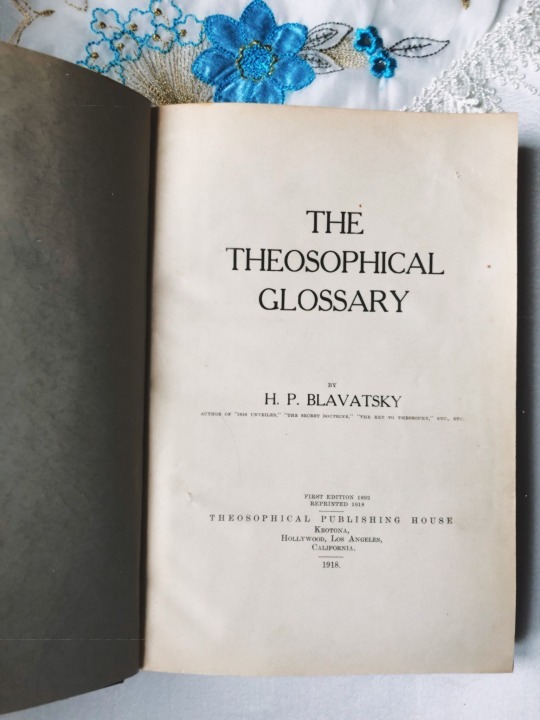

Blavatsky, Helena "The Theosophical Glossary" published originally in 1892, this version is a reprint of 1918. This posthumous work, purposes to give information on the principal Sanskrit, Pahlavi, Tibetan, Pâli, Chaldean, Persian, Scandinavian, Hebrew, Greek, Latin, Kabbalistic and Gnostic words. Defining occult terms generally used in Theosophical literature.

Most information are taken from the Kabbalah, which is illustrate Hermetic or Rosicrucian doctrines. Blavatsky also took definitions from "The Sanskrit-Chinese Dictionary" by Eitel "The Hindu Classical Dictionary" by Dawson "The Vishnu Purâna" by Wilson "The Royal Masonic Cyclopoedia" of Kenneth Mackenzie
Russian mystic of German descent Madame Blavatsky is know for her esoteric works and co-founding of the Theosophical Society. Still today her meaning is moving between an enlighted Sage and charlatan, as we can not determine which biographical information is "true" (which is a northworthy fact, as the Theosophical Society claimed the Truth as the highest value... More information in the first lemma) or embellished to create an alluring myth. Despite the carefullness in which we should handle all spiritual world-views and explanatory principles, it is an undeniable polygot venture and can support to arouse a deeper understanding of the synthesis of religion, philosophy and science. Indisputable there is more between earth and space, as we can measure and see.

Actually I had photographed more, but due to the limit of a post, I have selected some exemplary and interesting pages... It is also sad, that Altaic Shamanism (Tengrism) or other spiritual ideas e.g. from southern Africa or South-East-Asia, are unregarded. Imagine how motifs, we thought tailored in our region, appear all around the world! What a fantastic conception, but also human-strenght exceeding project this would be !!!


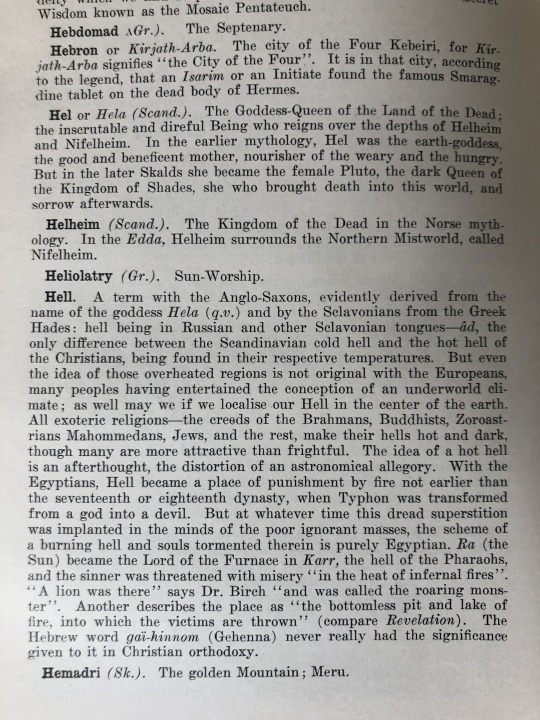


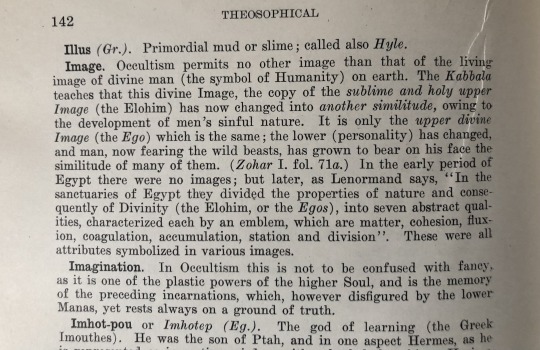

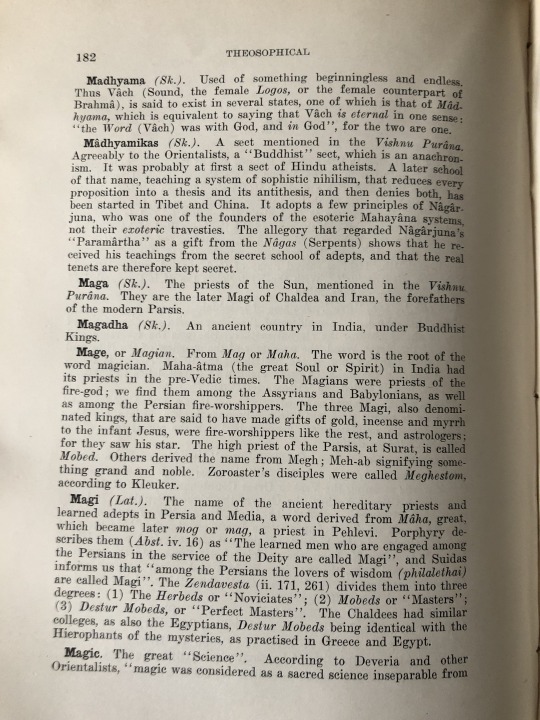

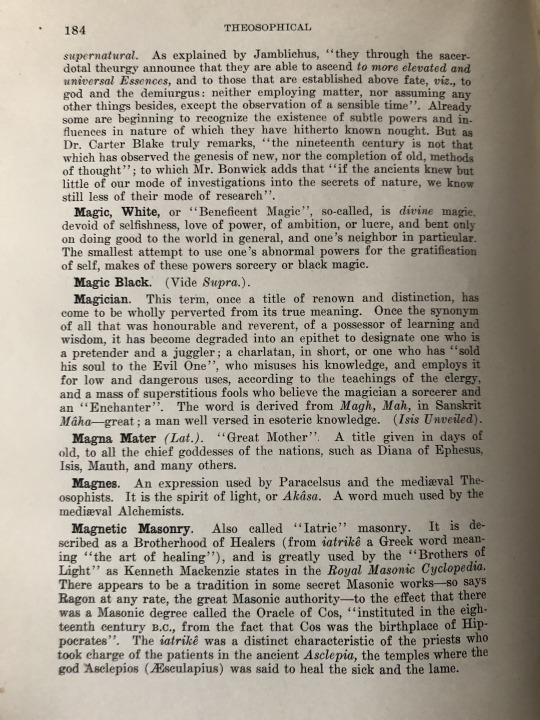

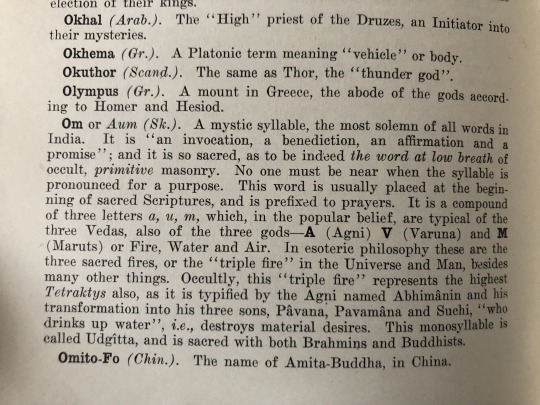
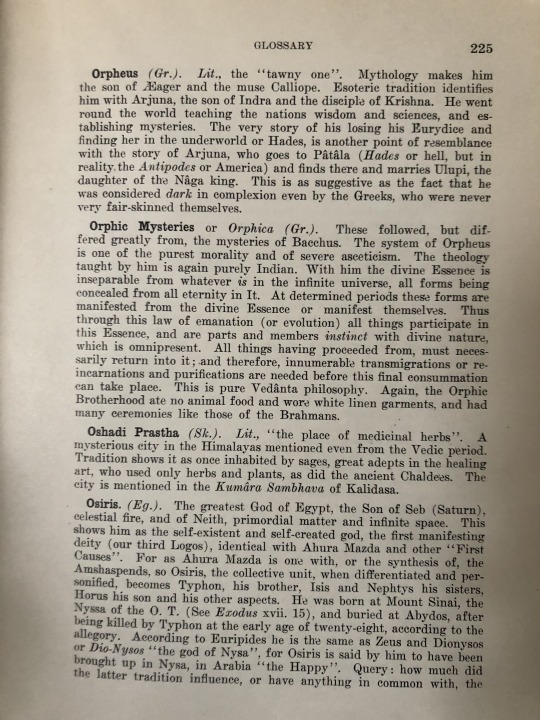





#literature#occult literature#Theosophical#Modern Philosophy#Occultism#occult culture#The Theosophical Society#H. P. Blavatsky#Blavatsky#Russian mystic#mystic#Glossary#Antiquarian Book#antiquarian book#antiquarian#19th century literature#Ancient Wisdom#ancient knowledge#1918#etymology#cosmogony#metaphysical speculations#spirituality#spirit and soul#theories of the First Cause#mysticism#Causeless Cause#truth#book cover#bookworm
7 notes
·
View notes
Text
NOVEDAD EDITORIAL: «Collected Writtings Tomos VII y VIII» de H. P. Blavatsky
Presentación por parte de José Rubio Sánchez de una nueva edición por la Editorial Dagón, de los libros «Collected Writtings Tomos VII y VIII» de H. P. Blavatsky.
youtube
View On WordPress
0 notes
Text


“Theosophy, on earth, is like the white ray of the spectrum, and each religion only one of the seven colours.” — H. P. Blavatsky image: Diver @ DeepDiverQ
26 notes
·
View notes
Text

“Darkness is the one true actuality, the basis and root of Light, without which the latter could not manifest itself, nor even exist.
Light is matter and Darkness pure spirit.
Darkness, in its radical, metaphysical basis, is subjective and absolute Light. While the latter, in all its searing effulgence and glory, is merely a mass of shadows, as it can never be eternal, and is simply an illusion or maya.” - H. P. Blavatsky.
17 notes
·
View notes
Text

L'anima conosce già ciò che la mente cerca disperatamente di comprendere.
L'anima conosce già ciò che noi non abbiamo ricordato in questa vita.
L'anima già conosce, e può, se la lasciamo, ricordarcelo.
Lasciate parlare l'anima.
H. P. Blavatsky
5 notes
·
View notes
Text

Hazlarımız ve arzularımız bize hiçbir şey öğretmez.
Asıl olana varmamızın tek yolu yaşam deneyimlerimizdir. Bunların çoğu da acılardan, ızdıraplardan oluşur.
* H. P. Blavatsky
9 notes
·
View notes
Text









"At the very circle of the Arctic Pole, the existence of a sea which never freezes and a continent which is ever green pink" - H. P. Blavatsky
Hyunjin -> The Arctic Ocean
~~~~🌊~~~~
Requested by -> @oddinary-charmer

#ummmmm I hope you like it.. lmao it looks nothing like what I thought it would#skz#stray kids#hwang hyunjin#staysource#userbeepls#usersa#usertsu#userwinterfloral#usermissye#bitsforkitts#adriblr#<3#juiceofmoons#juiceofmoons requested
72 notes
·
View notes
Note
I would love some book recs from you, you seem like such a cool person
Since I don't know your preferences, I tried to add authors from different places and diverse themes. But still, most of the time I go back to the same topics (suspense, horror, queer lit, and erotism).
A little of everything The Well of Loneliness by Radclyffe Hall Nightmare Tales by H. P. Blavatsky Violin by Anne Rice The Talented Mr. Ripley by Patricia Highsmith The Dangers of Smoking in Bed by Mariana Enriquez The Gilda Stories by Jewelle Gomez Narcissus and Goldmund by Hermann Hesse (beautiful book) Mademoiselle de Maupin by Théophile Gautier Neuromancer by William Gibson (a classic) Carmilla by Sheridan Le Fanu Maurice by E. M. Forster The Valancourt Book of World Horror Stories
Japanese authors Revenge: Eleven Dark Tales by Yōko Ogawa The Face of Another by Kobo Abe The Woman in the Dunes by Kobo Abe Kokoro by Natsume Sōseki Audition by Ryu Murakami The Key by Junichirō Tanizaki
Cats (if you like them) A Cat, Shozo, and Two Women by Junichirō Tanizaki I Am a Cat by Natsume Sōseki The Cat That Saves Books by Natsukawa Sosuke The Guest Cat by Takashi Hiraide
Short Stories The Shining Pyramid by Arthur Machen Ringing the Changes by Robert Aickman House of Mist by Maria Luisa Bombal The Old Nurse’s Story by Elizabeth Gaskell
If you want to talk about any of them or recommend something, feel free to dm me
10 notes
·
View notes
Text
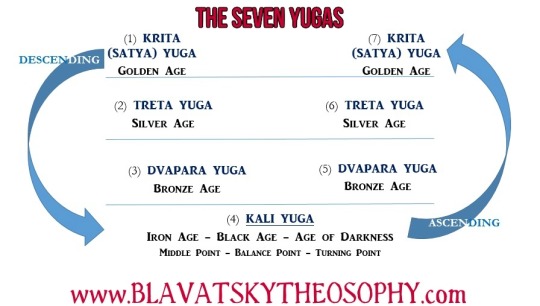
It is quite well known that Hinduism teaches the existence of four Yugas or Ages which together comprise the Maha-Yuga or “Great Age,” which is itself but an extremely minuscule and fleeting part of the entire Maha-Kalpa, the life cycle of the manifested Universe.
The names and durations assigned to the Yugas are as follows:
1st – Satya Yuga (also called Krita Yuga) – Golden Age – 1,728,000 years
2nd – Treta Yuga – Silver Age – 1,296,000 years
3rd – Dvapara Yuga – Bronze Age – 864,000 years
4th – Kali Yuga – Iron Age – 432,000 years
Total: 4,320,000 years (The Maha-Yuga)
According to Hindu tradition, we are currently in the Kali Yuga, which is said to have begun around 5,000 years ago with the death of Krishna, the great divine Teacher and Reformer who is the central figure of the Bhagavad Gita, and for whom there is evidence that he really once lived on Earth.
In the teachings of Theosophy, H. P. Blavatsky informs us in “The Secret Doctrine” that “The year of the Kaliyuga is said to have begun between the 17th and 18th of February in the year 3102 B.C.” (Vol. 2, p. 435) and clarifies that in fact “the instant of the beginning of Kali-Yuga” was “2h. 27m. 30s. a.m. of February 16th” of that year, 5,124 years ago as of 2022 (Vol. 1, p. 662).
It’s easy to work out that the Kali Yuga still has 426,876 years remaining, an almost unimaginably lengthy period of time!
But how literally are we to take these numbers? In his article titled “Cycles,” William Quan Judge shows the hidden numerical code present in the figures of the Yuga chronology.
The Satya Yuga is said to last for 1,728,000 years. Add 1+7+2+8 and the result is 18.
The Treta Yuga is said to last for 1,296,000 years. Add 1+2+9+6 and the result is 18.
The Dvapara Yuga is said to last for 864,000 years. Add 8+6+4 and the result is 18.
The Kali Yuga is said to last for 432,000 years. Add 4+3+2 and the result is 9.
Add 18+18+18+9 and the result is 63. Add those two numbers, 6 and 3, together, and the result is 9. Multiply 6 by 3 and the result is 18. Add that 1 and 8 together and the result is 9. This is undoubtedly of great significance but its real meaning has not been revealed, neither by Mr Judge nor by HPB nor by any of the Masters.
In his important book “The Ocean of Theosophy” (p. 126) Mr Judge writes that, “At the present time we are in a cycle of transition, when, as a transition period should indicate, everything in philosophy, religion and society is changing. In a transition period the full and complete figures and rules respecting cycles are not given out to a generation which elevates money above all thoughts and scoffs at the spiritual view of man and nature.”
Whilst the above figures from the chronologies of exoteric Hinduism are generally used and mentioned in the Theosophical teachings, HPB makes this statement in “The Secret Doctrine” Vol. 2, p. 67:
“Such computations as are given in Manu and the Puranas [Note: These ancient Hindu texts are the main source for the figures of the durations of Yugas, Manvantaras, Pralayas, Kalpas, etc.] – save trifling and most evidently intentional exaggerations – are, as already stated, almost identical with those taught in esoteric philosophy.”
So within those figures there are indeed some “exaggerations,” she says, albeit – for whatever reason – “intentional exaggerations” but on the whole the figures are “almost identical” with those accepted by the Gupta Vidya or Secret Doctrine or Esoteric Philosophy of the Brotherhood of Masters of Wisdom. The fact that they are almost identical and thus not identical is good reason for Theosophists to not focus on or present these numbers as if they are literal, unquestionable, wholly accurate, absolute facts, which has unfortunately been the approach in many cases. But as the true figures or numbers are not given to the public, it appears the exoteric Hindu ones are considered by the Masters to be “close enough” to use, provided that one remembers that they are not the real, literal thing. As will be seen below, HPB says the figures given for the Yugas are only “an approximate duration.”
We also have these words from “The Secret Doctrine”:
“It had been declared from the first and has been repeatedly asserted since that no Theosophist, not even as an accepted chela – let alone lay students – could expect to have the secret teachings explained to him thoroughly and completely, before he had irretrievably pledged himself to the Brotherhood and passed through at least one initiation, because no figures and numbers could be given to the public, for figures and numbers are the key to the esoteric system.” (Vol. 1, p. 164)
“The figures belonging to the Occult calculations cannot be given – as the Masters have many times declared – outside the circle of pledged chelas, and not even these can break the rules.” (Vol. 1, p. 170)
“We are not given the figures of the Great Kalpa, and are not allowed to publish those of our small Yugas, except as to the approximate duration of these.” (Vol. 1, p. 206)
“We are not taught figures which are and will remain secret with the Masters of Occult Science, as justly stated in “Esoteric Buddhism.”” (Vol. 2, p. 251)
Another good reason for not categorically “nailing it down” is because a surprisingly little known article by HPB lifts the veil to some degree on the true esoteric system, revealing that there are in fact seven Yugas, a truth which should have already presented itself to the intuition of the student of Theosophy, who knows well that all manifestation is of a septenary nature and that the golden key to understanding the mysteries of the Universe is to apply the law of correspondence and analogy. It is also made clear in “The Secret Doctrine” and elsewhere that the Hindu system as a whole (i.e. not merely on the subject of the Yugas but on virtually every subject) is generally a fourfold system, rather than sevenfold, and that while the fourfold approach can make things simpler and easier to grasp, it is not the complete truth of things but rather a condensation or compression of the sevenfold reality.
Instead of passing through the Golden Age, Silver Age, Bronze Age, Iron Age (“an age BLACK WITH HORRORS” – “The Secret Doctrine” Vol. 1, p. 645) and then starting the fourfold cycle all over again by somehow jumping from the darkest depths of the Iron Age into a new Golden Age, it appears that the Maha-Yuga actually follows the same type of involutionary and evolutionary arc as the seven rounds of the seven globes of our planetary chain. There is a gradual arc of descent, beginning at a pure, high, but relatively unconscious and unintelligent state, which eventually reaches the very lowest point to which it can go, after which there is a gradual arc of ascent, back up the same scale through which it had descended, but this time with the invaluable addition of acquired consciousness, intelligence, and soul experience. This is described as “the shadowy arc” and “the luminous arc.”
This information comes from a brief article by HPB published in January 1884 under the title “Premature and Phenomenal Growths”. One might not expect an article with such a title to contain such an important key but this is all the more reason why – as the articles on this site frequently emphasise – we should always pay very close and studious attention to everything HPB has written, for there is not one single unimportant or irrelevant sentence or paragraph in all the many thousands of pages of her writings.
Towards the end of that article, which is published today in the first volume of “H. P. Blavatsky Theosophical Articles” by Theosophy Company for the United Lodge of Theosophists, she quotes the text of what she calls “a prophecy in certain Asiatic old books.” Its content and style can be seen to be of the exact same type as the many esoteric commentaries quoted from a few years later throughout the two volumes of “The Secret Doctrine,” particularly in the second volume which is titled “Anthropogenesis.”
We have put in bold the sentence which most relates to this present subject:
“And as the fourth (race) was composed of Red-yellow which faded into Brown-white (bodies), so the fifth will fade out into white-brown (the white races becoming gradually darker). The sixth and seventh Manushi (men?) will be born adults; and will know of no old age, though their years will be many. As the Krita, Treta, Dvapara and Kali (ages) have been each decreasing in excellence (physical as well as moral) so the ascending – Dvapara, Treta, and Krita will be increasing in every excellence. As the life of man lasted 400 (years in the first, or Krita Yuga), 300 (years in Treta), 200 (years in Dvapara) and 100 (in the present Kali age); so in the next (the 6th Race) (the natural age of man) will be (gradually increased) 200, then 300 and 400 (in the last two yugas).”
This is clear enough – there is a Krita Yuga, a Treta Yuga, a Dvapara Yuga, a Kali Yuga, and then another Dvapara Yuga, another Treta Yuga, and another Krita Yuga, which closes the sevenfold cycle. This has been illustrated in the diagram at the top of this article.
One thing which is curious about the above quote is that it equates the Sixth Root Race with the ascending Dvapara Yuga or Bronze Age. This is curious seeing as “The Secret Doctrine” states in several places that the Kali Yuga will not come to an end until the end of the Sixth Root Race, meaning that the next Yuga would not begin until around the start of the Seventh Race.
Could it be, therefore, that really the Kali Yuga will end before our Fifth Root Race comes to an end?
Raghavan Iyer believed so. In his article “Involution” (first published in the December 1982 issue of “Hermes” by the Santa Barbara Lodge of the United Lodge of Theosophists) he states, “. . . the present Kali Yuga. This yuga . . . will indeed end before the completion of the present Fifth Root Race, and be followed by an ascent through the yugas towards the Satya Yuga.” Due to HPB’s “Premature and Phenomenal Growths” article being so little known, this statement would probably be considered by many as “untheosophical” whereas in fact it is completely in line with the esoteric prophecy translated therein by HPB. Iyer – apparently the only Theosophical writer to have noticed or at least commented upon the doctrine of the Seven Yugas – continues: “The four yugas may be understood in terms of a descent from the most golden age to the most decadent, followed by a reascent to a golden age that represents a spiralling spiritual advance over the starting-point of the cycle.”
Interestingly, the event known as the “Coming of Maitreya” or “Coming of the Kalki Avatar” and which HPB always speaks of as being due at the end of the Kali Yuga and its coincident close of the Sixth Root Race and start of the Seventh (see Maitreya in The Light of Real Theosophy) is indicated in her “Theosophical Glossary” entry for “Maitreya Buddha” to be due instead “during the seventh (sub) race” rather than Root Race. Why “sub” is there in brackets and why that expression is not elaborated upon by her is unknown; most likely it is because no more can be revealed than this at this present time but it should hopefully make us realise that many things may not be as “cut and dried” as we would like them to be, hence the importance of our guarding against dogmatic assertions. That “Glossary” expression could however be further evidence that the Kali Yuga is indeed going to draw to a close by, or during, the seventh sub-race of this present Fifth Root Race.
Almost nothing about how the Yugas (whether four or seven in number) relate or correspond to the Seven Root Races is divulged in the Theosophical literature, with perhaps the most notable exception being the implication in “The Secret Doctrine” Vol. 2, p. 147, that the Dvapara Yuga or Bronze Age (which preceded our Kali Yuga) began around the start of our Fifth Root Race. We would all surely admit that even if we had been given more information on these points, we would not know what to do with it.
Yet although we cannot say for definite exactly how long the Kali Yuga or any Yuga actually lasts, nor at which precise point in the Races it will end, one thing which is made very clear and definite throughout the Theosophical literature is that the closing of the first 5,000 year cycle of the Kali Yuga would be an extremely serious, important, and momentous event in the evolution of humanity. There are many references to this in many places. In “Letters That Have Helped Me” (p. 97) William Judge writes, “The present cycle, which closes Nov. 17th, 1897 – Feb. 18th, 1898, is one of the most important of any that have been.”
It is, however, only the first 5,000 years of the Kali Yuga that have come to a close, not the Kali Yuga itself.
The idea popular in the New Age Movement that the entire Kali Yuga has finished and that we are already in the Golden Age or Satya Yuga, or that the Golden Age began in 2012, is not only unphilosophical but has no basis or foundation in anything at all other than the imaginations and fantasies of psychics and “lightworkers.”
Such wishful thinking is of course entirely understandable but it will not truly help anyone. As HPB once wrote, “Has the “last age” – the Age of Iron, or Kali Yuga – closed since then? Quite the reverse, since it is shown to be in full sway just now, not only because the Hindus use the name, but by universal personal experience. … Is it this age of ours that is the promised “Golden Age” – in which neither the venom of the serpent nor of any plant is any longer lethal, and in which we are all secure under the mild sway of God-chosen sovereigns? The wildest fancy of an opium-eater could hardly suggest a more inappropriate description, if it is to be applied to our age or to any age since the year one of our era.”
On p. 377 of the first volume of “The Secret Doctrine,” HPB remarks that “It is curious to see how prophetic in almost all things was the writer of Vishnu Purana when foretelling to Maitreya some of the dark influences and sins of this Kali Yug.” She then quotes from this ancient Hindu scripture known as the Vishnu Purana, which in describing the development of the Kali Yuga says amongst many other things:
“Wealth and piety will decrease until the world will be wholly depraved. Property alone will confer rank; wealth will be the only source of devotion; passion will be the sole bond of union between the sexes; falsehood will be the only means of success in litigation; and women will be objects merely of sensual gratification. ….. External types will be the only distinction of the several orders of life; ….. a man if rich will be reputed pure; dishonesty (anyaya) will be the universal means of subsistence, weakness the cause of dependence, menace and presumption will be substituted for learning; liberality will be devotion; mutual assent, marriage; fine clothes, dignity. He who is the strongest will reign; the people, unable to bear the heavy burden, Khara bhara (the load of taxes) will take refuge among the valleys. … Thus, in the Kali age will decay constantly proceed, until the human race approaches its annihilation (pralaya). … When the close of the Kali age shall be nigh, a portion of that divine being which exists, of its own spiritual nature … shall descend on Earth … (Kalki Avatar) endowed with the eight superhuman faculties. … He will re-establish righteousness on earth, and the minds of those who live at the end of Kali Yuga shall be awakened and become as pellucid as crystal.”
In the first of the two booklets titled “Conversations on Occultism,” Mr Judge presents a conversation between himself (as “Student”) and HPB (as “Sage”) under the title “The Kali Yuga – The Present Age.” In this, the Sage says, “There is one thing peculiar to the present Kali-Yuga which may be used by the Student. All causes now bring about their effects much more rapidly than in any other or better age. A sincere lover of the race can accomplish more in three incarnations under Kali-Yuga’s reign than he could in a much greater number in any other age. Thus by bearing all the manifold troubles of this Age and steadily triumphing, the object of his efforts will be more quickly realized, for, while the obstacles seem great, the powers to be invoked can be reached more quickly.”
The Student asks, “Even if this is, spiritually considered, a Dark Age, is it not in part redeemed by the increasing triumphs of mind over matter, and by the effects of science in mitigating human ills, such as the causes of disease, disease itself, cruelty, intolerance, bad laws, etc.?”
To this comes the answer: “Yes, these are mitigations of the darkness in just the same way that a lamp gives some light at night but does not restore daylight. In this age there are great triumphs of science, but they are nearly all directed to effects and do not take away the causes of the evils. Great strides have been made in the arts and in cure of diseases, but in the future, as the flower of our civilization unfolds, new diseases will arise and more strange disorders will be known, springing from causes that lie deep in the minds of men and which can only be eradicated by spiritual living.”
This particular dialogue ends with the question, “Are there any causes, other than the spread of Theosophy, which may operate to reverse the present drift towards materialism?”
The Sage replies, “The spread of the knowledge of the laws of Karma and Reincarnation and of a belief in the absolute spiritual unity of all beings will alone prevent this drift. The cycle must, however, run its course, and until that is ended all beneficial causes will of necessity act slowly and not to the extent they would in a brighter age. As each student lives a better life and by his example imprints upon the astral light the picture of a higher aspiration acted in the world, he thus aids souls of advanced development to descend from other spheres where the cycles are so dark that they can no longer stay there.”
But the present situation is not as gloomy as one might imagine, for there are cycles within cycles, and – Theosophy says – there is great potential for a type of golden age within the Dark Age of the Kali Yuga. Such a golden age will not be the Satya Yuga but rather something else. It results from the fact that the Aquarian Age, the New Age of Aquarius, began very shortly after the 20th century began, just a few years after the second sub-cycle of the Kali Yuga was ushered in. This zodiacal or astrological Age of Aquarius will last for around 2,160 years. But that is another subject and explored in another article.
~ BlavatskyTheosophy.com ~
One thought on “The Seven Yugas”
George Muttathil
SEPTEMBER 29, 2014 AT 2:00 PM
#yoga#spirituality#theosophy#cosmology#occult#esoteric#yuga#kali yuga#vedic astrology#ancient astrology#astrology
22 notes
·
View notes
Text
"The whole essence of truth cannot be transmitted from mouth to ear. Nor can any pen describe it, not even that of the recording Angel, unless man finds the answer in the sanctuary of his own heart, in the innermost depths of his divine intuitions."
~ H. P. Blavatsky

20 notes
·
View notes
Text
Herramientas para defenderse del mal - Enrique Reig
Charla de Enrique Reig Pintado, Miembro de la Sociedad Teosófica en México y presidente de la Federación Teosófica Interamericana, acerca del mal, sus manifestaciones, y los medios que puede tener el aspirante espiritual para combatir estas fuerzas, el 10 de marzo de 2024.
youtube
View On WordPress
0 notes
Text

“And now it stands proven that Satan, or the Red Fiery Dragon, the ‘Lord of Phosphorus,’ and Lucifer, or ‘Light-Bearer,’ is in us: it is our Mind.” — H. P. Blavatsky
✶ COMMS OPEN ✶ @altioraem
51 notes
·
View notes
Text

“And now it stands proven that Satan, or the Red Fiery Dragon, the ‘Lord of Phosphorus,’ and Lucifer, or ‘Light-Bearer,’ is in us: it is our Mind.” — H. P. Blavatsky
✶ COMMS OPEN ✶ @ altioraem
26 notes
·
View notes
Quote
The universe is the combination of a thousand elements, and yet the expression of a single spirit - a chaos to the sense, a cosmos to the reason.
H. P. Blavatsky
14 notes
·
View notes
Text
Echoes From the Gnosis - The Gnosis of the Mind - All Volumes

Echoes From the Gnosis Echoes From the Gnosis - The Gnosis of The Mind is written by G. R. S. Mead the first modern scholar of Gnostic tradition. G. R. S. Mead was the secretary of H. P. Blavatsky and in 1906 he published the first volume of eleven in the series Echoes From the Gnosis. The works are a combination of translations and interpretations of ancient Gnostic writings. Long before the discovery of the Nag Hammadi Library, Mead translated these esoteric texts of various origins such as Christian and Roman. Unfortunately, I have only been able to find six of the eleven volumes, download Echoes From the Gnosis here:

The Gnosis of The Mind (Echoes from the Gnosis Vol. I) The Hymns of Hermes (Echoes from the Gnosis Vol.II) The Hymn of Jesus (Echoes from the GnosisVol. IV) A Mithriac Ritual (Echoes from the Gnosis Vol. VI) The Gnostic Crucifixion (Echoes from the Gnosis Vol. VII) The Hymn of the Robe of Glory (Echoes from the Gnosis Vol. X)
Who was G. R. S. Mead?
George Robert Stow Mead was born in 1863 in Nuneaton, Warwickshire, England. He was educated at St John's College, Cambridge, where he studied mathematics and classics. His intellectual prowess was evident from a young age, and his academic journey set the stage for his later work in philosophy, religion, and mysticism. Involvement with Theosophy In 1889, Mead became a member of the Theosophical Society, a group dedicated to exploring esoteric knowledge and advancing a synthesis of science, religion, and philosophy. He was particularly influenced by Helena Petrovna Blavatsky, the society's co-founder, becoming her secretary and developing a strong interest in the esoteric and occult that would define his life's work. Contributions to Esoteric Studies Mead is perhaps best remembered for his comprehensive studies on Hermeticism, Gnosticism, and other ancient religions and philosophies. Unlike many scholars of his time, he approached these subjects with a sense of spiritual respect and scholarly rigor, helping to revive interest in religious traditions outside of mainstream Christianity. Notable Works Throughout his career, G.R.S. Mead produced an impressive array of books and papers that explored a wide range of topics in religion, philosophy, and the esoteric. Some of his most influential works include: - Fragments of a Faith Forgotten (1900): A detailed exposition of early Christian Gnosticism, exploring texts and beliefs that were suppressed or marginalized by orthodox Christianity. - Thrice-Greatest Hermes (1906): A comprehensive study of Hermeticism, focused on texts attributed to Hermes Trismegistus and their significance in the broader context of Mediterranean spirituality and philosophy. - Pistis Sophia (1921): An important Gnostic text translated and commented upon by Mead, providing unique insights into early Gnostic teachings and cosmology. - Gnostic John the Baptizer (1924): This work comprises selections from Mandaean texts, offering insights into an early religion that revered John the Baptist as a central figure. - The Doctrine of the Subtle Body in Western Tradition (1919): An exploration of the concept of the 'subtle body' in Western spiritual traditions, discussing ideas of astral travel, aura, and other esoteric concepts related to human consciousness. - Apollonius of Tyana (1901): A historical investigation of the life of Apollonius of Tyana, a philosopher and miracle-worker in 1st-century Roman Empire, often compared to Jesus of Nazareth. Legacy G.R.S. Mead died in 1933, but his influence endures. He is credited with making esoteric and Gnostic studies more accessible to a broader audience outside of the academic sphere, and his works continue to be referenced and valued for their insight and historical significance in the study of Western esotericism. Despite the passage of time and the evolution of scholarly standards, Mead's passionate pursuit of ancient wisdom helps keep these discussions alive in contemporary spiritual and philosophical debates. Read the full article
#Blavatsky#Christian#EchoesFromtheGnosis#EsotericStudies#G.R.S.Mead#Gnostic#Greek#Mysticism#NagHammadiLibrary#Roman#theosophy
4 notes
·
View notes
